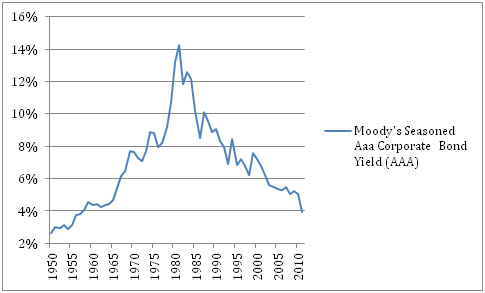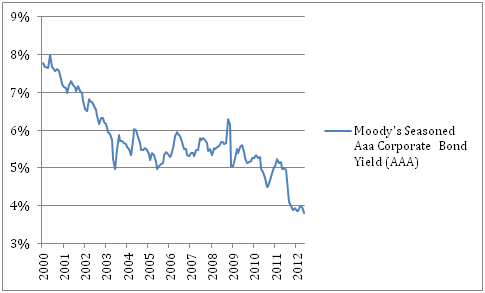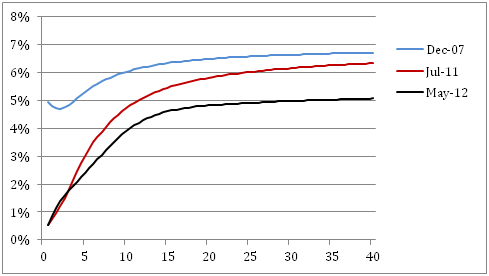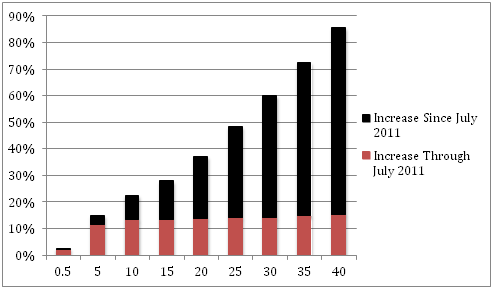How low can you go? Interest rates and DB plans
In this article we discuss the impact of the decline in interest rates on defined benefit plans. We begin with a discussion of what has happened to interest rates over the long- and short-term. Next, we discuss the Federal Reserve’s “Operation Twist” and its effect on interest rates. We then turn to the impact of decreased interest rates on valuations, lump sum calculations, de-risking strategies and cash balance plans. We conclude with a brief discussion of proposed interest rate stabilization legislation.
Interest rate trends
The following is a chart of long-term interest rates for the last 60 years.
Chart 1: Moody’s Seasoned Corporate Bond Yield (AAA) 1950-2011 (December monthly average)

Interest rates peaked in 1981 — the high for Aaa long-term corporates came in September 1981 at 15.49%. Rates have been going down since then. It’s worth considering that, even though it is axiomatic that no one knows which direction interest rates are going, interest rates have (with the exceptions the chart illustrates) generally gone steadily in one direction — down — for the last 30 years. And for the 30 years before that they went steadily up.
The following chart isolates the more recent trend in long-term rates — from 2000 through May 2012.
Chart 2: Moody’s Seasoned Corporate Bond Yield (AAA) January 2000-May 2012 (monthly average)

Bottom line: the trend in interest rates over the last 12 years has been steadily and significantly down — the rate on long-term corporates is now half what it was 12 years ago, a drop of 400 basis points.
Defined benefit plan finance
Traditional defined benefit plans pay a formula benefit at a future date (retirement age). Money is set aside in a trust to fund this (future) benefit. For accounting (expense) and funding (cash) purposes, the sponsor is required to value this benefit, and the value then directly affects what cost is expensed to the sponsor’s income statement and how much cash must be contributed to the plan.
As interest rates go down, valuations go up, and expense/cash cost goes up. There is considerable “smoothing” of volatility, both under the accounting regime (FAS 87 and related accounting standards) and (to a lesser extent) the funding regime (ERISA as amended by the Pension Protection Act). But while smoothing can mitigate short-term volatility, generally smoothing will at best only delay (and drag out) the impact of the long-term downward trend of interest rates.
Movements since Operation Twist
In September 2011, the Federal Reserve announced that “To support a stronger economic recovery and to help ensure that inflation, over time, is at levels consistent with the dual mandate [to foster maximum employment and price stability], the [Federal Open Market] Committee decided today to extend the average maturity of its holdings of securities.” In effect, the Fed sold short-term debt and bought medium- and long-term debt, which, according to the Fed “should put downward pressure on longer-term interest rates and help make broader financial conditions more accommodative.” The Fed’s action has been called “Operation Twist.”
The following chart shows the shape of the corporate bond yield curve for the months of December 2007, July 2011 and May 2012. The significant (80-120 basis point) drop in medium- and long-term interest rates from July 2011 to May 2012 includes the impact of the Fed’s Operation Twist.
Chart 3: Corporate bond yield curve December 2007, July 2011 and May 2012

Source: Internal Revenue Service Weighted Average Interest Rates, Yield Curves, and Segment Rates (investment grade corporate bonds)
We note that Operation Twist explicitly aims to affect interest rates on federal government securities. The chart above is for corporate securities and shows the indirect effect of the Fed’s action, along with other variables, on the corporate interest rate market. For both plan funding (under ERISA) and expensing (under Financial Accounting Standards Board rules), the relevant rates are those on investment grade corporate bonds.
On June 20, 2012, the Fed announced that it was extending Operation Twist through the end of 2012. The Fed stated: “The continuation of the maturity extension program will proceed at the current pace and result in the purchase, as well as the sale and redemption, of about $267 billion in Treasury securities by the end of 2012.”
How has the decline in interest rates and Operation Twist affected corporate DB plans?
The following chart shows (1) the total increase in the value of payments, at various points in the future, attributable to changes in interest rates since 2007 and (2) the portion of that increase since July 2011, which includes the impact of Operation Twist.
Chart 4: Affect of Operation Twist on DB plan liability valuations

For example, the value of a payment due 5 years in the future increased (because of the drop in interest rates) around 12% from December 2007 to July 2011 and another 3% (to around 15%) from July 2011 to May 2012. On the other hand, the value of a payment due 20 years in the future increased around 14% from December 2007 to July 2011 and another 24% (to around 38%) from July 2011 to May 2012.
A couple of observations: Traditionally, central banks (like the Fed), in recessions, have targeted lowering short term interest rates to increase economic activity. Such a policy affects plans with shorter durations, but the impact is generally not significant due to fewer years of compounding. Targeting medium- and long-term rates is relatively novel and, as the above chart indicates, has had an impact on plans with longer durations in a way that past changes in short-term interest rates have not.
The changes in interest rates since December 2007 and since July 2011 have clearly had a significant impact on liability valuations. Even prior to the implementation of Operation Twist, low interest rates were driving up DB plan funding costs. According to a widely cited study by the Society of Actuaries (The Rising Tide of Pension Contributions Post-2008: How much and when?):
We expect a significant increase in the level of future [DB plan] contributions, based on the projected level of required contributions. We project an average level of about $90 billion per year over the ten years beginning with 2010, peaking at about $140 billion in 2016.
While it is not clear how much of the recent movement in interest rates is attributable to Operation Twist, we find it significant that the decline in rates and flattening of the yield curve in recent months are more substantial than anything we’ve seen over the past several years, and the changes are consistent with the Fed’s stated goal in implementing Operation Twist. Given all this, it strikes us as fair to conclude that Operation Twist has exacerbated the difficulties of pension sponsors (and continues to do so).
Lump sums, annuity settlements and de-risking
Prior to the passage of the Pension Protection Act (PPA), lump sums in defined benefit plans were calculated using the interest rate on 30-year Treasuries. Under the PPA, beginning in 2012, lump sums are calculated based on the corporate bond yield curve (but using spot rates rather than smoothed rates). (Chart 3 shows that yield curve for, among other periods, May 2012.)
Generally, rates under the corporate bond yield curve are higher than the rate on 30-year Treasuries, producing lower lump sum values. The fact that the new PPA rates fully phased in, in 2012, has been cited by some as leading to recent “de-risking” transactions, in which inactive participants (i.e. those no longer working at the company but due a benefit) are offered an opportunity to take a lump sum. Rates are, nevertheless, at historic lows, and others have questioned whether settling benefits at such low rates makes sense.
A similar set of questions arises with respect to recent de-risking transactions involving annuity settlements. Generally, a settlement of DB liabilities (whether through a lump sum cash out or purchase of an annuity) involves locking in a “once and for all” cost at current interest rates. Indeed, most liability driven investment strategies, e.g., a significant reallocation of assets away from equities to fixed income securities, involve more or less the same thing — trading off a “settlement” at current interest rates for a reduction in interest rate-driven liability volatility.
Some question whether such strategies make sense in the current low interest rate environment. On the other hand, interest rates were at historic lows nine months ago, in July 2011 and have nevertheless gone down another 80-120 basis points since then.
Cash balance plans
Cash balance plans that provide an interest crediting rate that is indexed to current fixed income rates generally are not hurt by falling interest rates. The crediting rate under the plan resets (generally annually), and any fixed income assets held by the trust will generally increase in value as rates decrease. If, however, rates at some point begin to increase, then that process reverses — interest crediting rates reset up and the value of fixed income assets already in the portfolio when rates rise goes down.
Where the plan guarantees a flat interest crediting rate, the situation is more problematic. If short-term high quality corporates are yielding 1% and the plan is paying, e.g., a 4% interest crediting rate, then participants are getting, in effect, an above-market return, that will have to be paid for by the plan sponsor.
Legislative relief
There is currently under consideration in Congress a proposal to “stabilize” the interest rates used to value plan liabilities. We discussed one version of that proposal (included in the highway bill passed in the Senate) in our article Senate passes highway bill with DB funding relief. Oversimplifying, the Senate proposal would put a floor on valuation interest rates equal to, in 2012, 90% of a trailing 25-year average. That floor gets “lower” over 2013-2015, hitting “bottom” at 70% in 2016.
That proposal is now being considered as a “pay for” in connection with student loan relief and transportation legislation, with some predicting passage imminently.
* * *
We will continue to update you on legislation related to valuation interest rates.
